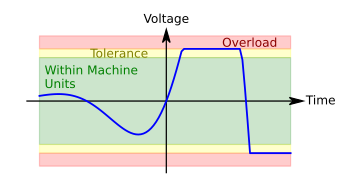Difference between revisions of "Machine Unit"
(+ some cartoon) |
m (Tfischer moved page Machine Units to Machine Unit over redirect) |
(No difference)
| |
Revision as of 04:46, 27 August 2021

Machine units are the conventions how to represent numbers on analog computers such as The Analog Thing (THAT). In digital context, these are typically called logic levels.
THAT works with logical one represented by +10V and logical minus one represented by -10V. It is helpful to thing in all quantities being bracketed within the real number interval [-1,+1]. In electrical engineering, this is called bounded in bounded out systems, as any computation has to produce results within this domain in order to be meaningful on an analog computer. These machine units are bipolar, this is in contrast to unipolar units such as 0V for logical zero and +5V for logical one in the digital TTL logic system.
Levels for output
When it comes to output which can be displayed on oscilloscopes, level shifting may apply. For instance, the Soundcard output operates with roughly ±1V.